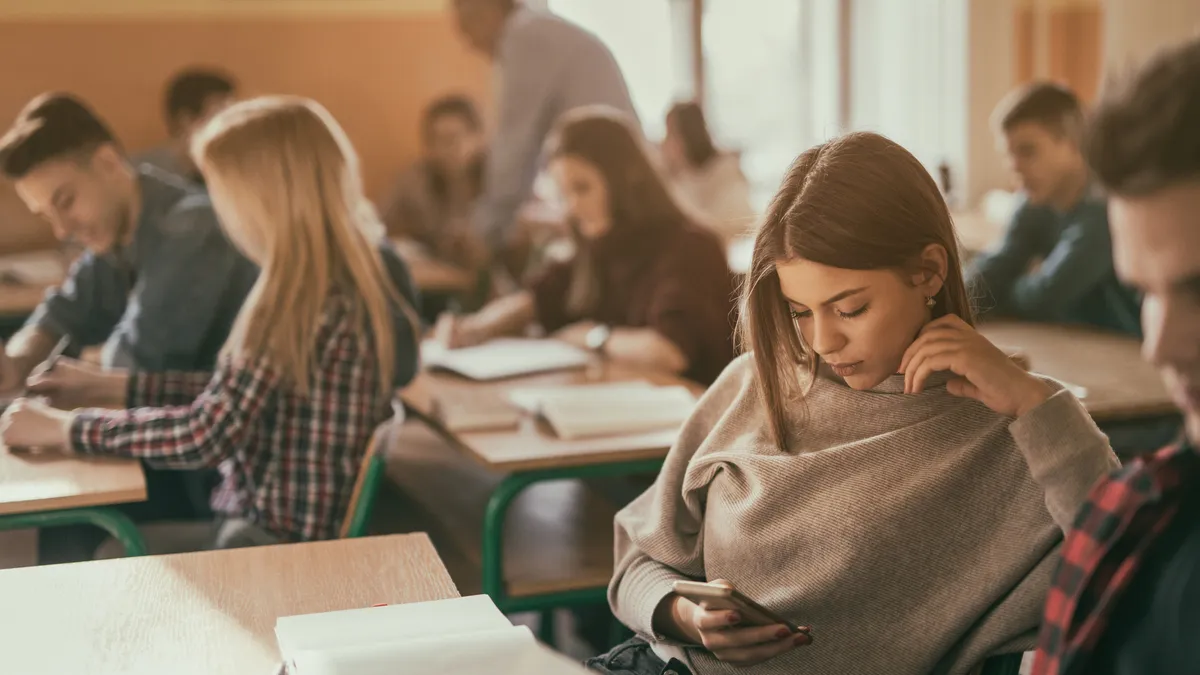When public schools in Orange County, Florida, began prohibiting students from using cellphones during the school day last fall, Melissa Byrd got an earful from her high school-age daughter.
“She complained a bit the first nine weeks,” Byrd recalls.
As a member of the school board in Orange County, Byrd had pushed for the ban. The measure, which extends to smartwatches and earbuds, passed unanimously in July 2023.
Like in many districts and states, educators in Orange County said student cellphone usage contributed to post-COVID spikes in discipline problems, including fights, bullying, interpersonal drama and insubordination in class.
“Students were coordinating [on phones] when to meet to have a fight, and they were bullying each other,” Byrd said. “There were just a lot of negative effects.”
The Orange County ban covers the entire school day including lunch and between classes. This went a step further than a statewide law approved the previous May that prohibits Florida public school students from using phones during instructional time.
And Florida is hardly alone.
New York City Public Schools, the nation's largest school district, is now considering a ban on cellphones during the school day. New York Gov. Kathy Hochul plans to propose a statewide ban on cellphones in schools in January. And in June, California Gov. Gavin Newsom proposed a statewide public school cellphone ban. Shortly afterward, the Los Angeles Unified School District approved a similar pilot program. It remains to be seen whether devices like smartwatches will also be banned.
“I have a lot of ambition around this,” said Nick Melvoin, the LAUSD Board of Education member who proposed the ban. “I hope kids are more focused, that academics improve, that kids are active at recess and lunch, and that it improves physical health, obesity and diabetes.”
Some parents push back
Not everyone is as enthusiastic about prohibiting students from having access to their phones all day. In a survey released by the National Parents Union in March, more than half of respondents (56%) said kids should be allowed to use phones during lunch and recess, and in class “for academic purposes approved by their teacher.”
“It’s 2024 — and all families rely on cellphones to stay connected,” said Keri Rodrigues, president of the National Parents Union, in a statement. “Banning cellphones outright in school or treating them like contraband instead of using effective classroom management is entirely unreasonable and not grounded in the reality we all live in.”
William Budington, senior staff technologist with the Electronic Frontier Foundation, a digital rights nonprofit, described cellphone bans as a “knee-jerk reaction.”
“Cellphones facilitate note-taking, research and documenting harassment and abuses of power by teachers,” Budington said. In some schools, he added, cellphones may be the only WiFi-connected devices students can access. During school shooting incidents, Budington said, students have called for help using cell phones. He also questioned whether classrooms would have working landline phones in the event of an emergency.
But in LAUSD, Melvoin said, schools will have time to fix any broken phones before the ban takes effect in January.
“There was a world where there were other ways to reach your child,” said Melvoin, who formerly taught middle school in Los Angeles. Students will always be able to use the class landline or go to the office to make a phone call, he said. “Texting your child during the school day isn’t a good practice. Even the vibration in their pocket is distracting.”
How are cellphone bans being enforced?
In July, the Delaware Senate approved funding for a pilot cellphone ban. Funds will pay for lockers or electronically locked pouches that schools can use to store students’ phones during the day.
As in Los Angeles, Delaware schools formerly operated under a policy that simply told students to keep their phones in their backpacks during class. That was mostly effective — until the pandemic, said Delaware State Sen. Eric Buckson, a former teacher who proposed the new ban, which he said may eventually include smartwatches.
“We were consistent, parents were receptive, and we had less problems,” he said. Then COVID came along. “Now we live in a world that requires instantaneous communication. I would understand, if it didn’t come with consequences.”
Fights during lunch and between classes have increased, Buckson said, and students aren’t paying attention in class.
In fact, these observations are backed up by studies. Learning is hard in a distracting environment, Buckson said, especially for students who struggle academically.
“It’s time that the grownups in the room get control of the environment,” he said. “It’s a no-brainer.”
Officials in Delaware, Los Angeles and Florida’s Orange County all said that students in their districts have access to electronic devices at school and can use them to send personal emails if needed.
In Orange County, where the ban has been in effect for a year, consequences for using a cellphone start with a warning and elevate to taking the phone away for the day. After the first nine weeks, Byrd said, schools reported few discipline referrals for phone use.
The district doesn’t have official data yet for last year’s referrals for phone use, but Byrd said there were 1,500 total referrals last year in the 200,000-student district.
During lunch at a high school Byrd visited last year, rather than being on their phones, some students had brought out board games and others were dancing. “What we saw kind of blew us away,” said Byrd, because students were having fun without their phones.
While one study found that banning cell phones in school may lead to better academic outcomes for the lowest-performing students, research into this question is scant. Byrd noted that there is only anecdotal evidence that academic performance is better since the ban, but she says the behavioral improvements make the new policy worthwhile.
“It actually went way better than we thought it would,” Byrd said.





 Dive Awards
Dive Awards










